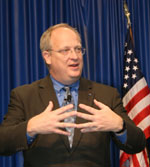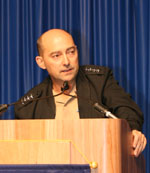Thursday, February 1, 2007
SIGNAL's Online Show Daily
West 2007
Day 2
Quote of the Day:
“It’s all about moving to the Web.”
—Dave Wennergren, deputy assistant secretary of defense (information technology and management), deputy Defense Department chief information officer.
 |
| Defense Department information official Dave Wennergren starts off day 2 of West 2007. |
And approaches are changing in the midst of the network-centric transformation. As networks grew, their interrelationships and lines of access and connectivity often became so complex and convoluted that their form shapes could not be sustained. Instead of a Tinkertoy nightmare, Wennergren offered, the new model should be that of a plasma ball—a single source of information that could be interconnected in any direction.
“The world is not about separate networks,” he said.
But many tasks must be accomplished to achieve this goal. Data must be available to be consumed in standard way. Configuration management is vital for operators to know all about the system. The department still must week its way through software to determine what it needs and what it doesn’t.
Some recent measures have helped key aspects of information. Rationalizing networks, which helped configuration management greatly and saved money, additionally has aided infrastructure security measures. Information assurance also has been enabled by common access cards, the use of which has reduced the information security threat. Biometrics continues to be a growth area for the Defense Department, Wennergren adds.
He called for an innovative partnership with industry. In this Web-based world, the department must align with standards and open architectures. For the department’s strategic planning, it must accelerate the development of a network-centric culture. The department also must network the warfighter, make information a force multiplier, facilitate warfighter access to intelligence and secure the network.
“Everything’s going digital,” Wennergren declared. “It’s all about moving to the Web.”
One of the day’s panels focusing on the 1,000-ship navy concept turned into a lively discussion about whether the U.S. Navy could even sustain its shipbuilding. Noted author and panel moderator Norman Polmar warned that the U.S. government faces some difficult decisions for its 313-ship future fleet. It must determine whether the Navy is building the right types of ships, especially with no foreign navy peer on the horizon. Another key issue is whether the $11 billion currently spent on shipbuilding each year will be sufficient—or is even sustainable.
 |
| Panelists discussing how to build the future fleet are (r to l) panel moderator Norman Polmar; Lt. Col. Frank Hoffman, USMC (Ret.); Eric Labs; Vice Adm. Martin J. Mayer, USN (Ret.); and Capt. Pat Sudol, USN. |
But Col. Hoffman’s bluntness was exceeded by the harsh admonishments of Eric J. Labs, senior analyst for naval forces and weapons at the Congressional Budget Office’s National Security Division. Labs painted a gloomy picture of Navy shipbuilding from both fiscal and logistical perspectives.
He called the goal of 313 ships by 2020 “disingenuous.” Two-thirds of that number already are in the fleet or are under construction. But even if the Navy could achieve its 313-ship goal, it couldn’t sustain it past 2027, he said. Surface combatants are falling faster than they are being acquired. And, by 2037 the number of ships in the fleet will be as small as it is today because some types of ships and submarines will leave the fleet without any replacements planned.
Labs went beyond Hoffman in criticizing the $11 billion annual shipbuilding budget. Even the Navy believes it will need an average of $16 billion each year over the next 30 years, he pointed out. But Labs believes a more accurate number is $21 billion annually over 30 years. That figure likely will be unsustainable as domestic federal spending on items such as Medicare explodes over the coming years.
“You will have a smaller, less capable fleet,” he declared.
The unified and combatant commanders’ perspective was offered by the head of the U.S. Southern Command (SOUTHCOM). Adm. James G. Stavridis, USN, told the Thursday luncheon crowd how the conference theme truly applied to operations in his area of responsibility.
“Our operations are a balance between swords and diplomacy,” he stated.
 |
| Adm. James G. Stavridis, USN, tells the luncheon audience about the challenges he faces as commander of the U.S. Southern Command. |
The countries of the Caribbean and South America have made great progress politically over the past 30 years. Instead of most nations being totalitarian states often run by juntas, as was the case three decades ago, all but one today—Cuba—are democracies. However, many problems that challenge those countries also concern SOUTHCOM.
Foremost among these is poverty. As much as 40 percent of the region’s populace lives on $1 a day. These countries with many poor also tend to have a wealthy segment that illustrates the extremes of their societies. And, many of these nations face trans-national threats such as drug production and smuggling, terrorism, corruption, urban gangs and natural disasters.
The major danger involves narcotics, especially because 25,000 Americans die each year from drugs or drug-related activities. Interdicting drug flow is similar to antisubmarine warfare, the admiral pointed out. It involves finding a platform that does not want to be found.
Some of these challenges can be addressed by military-to-military contacts, the admiral pointed out. The 1,000-ship navy concept is “made for South America,” he said. Countries such as Chile and Argentina have great navies that have performed superbly in joint exercises with their U.S. counterparts.
However, the difficulties in implementing that concept elsewhere also plague SOUTHCOM. The United States must develop better ways of communicating and sharing information with its allies, Adm. Stavridis charged. The greatest needs are for systems and intelligence that can be shared with these allies.
The command also needs language facility, the admiral offered. While waiting for artificial intelligence techniques to progress for broad translation capabilities, the admiral stated that his goal is for 70 percent of all operators to be able to speak either Spanish or Portuguese.
—Scheduled for Friday at West 2007: Speeches by Vice Adm. Mark J. Edwards, USN, deputy chief of naval operations for communication networks (N6), and Lt. Col. John A. Nagl, USA, commanding officer, 1st Battalion 34th Armor, Fort Riley, Kansas; along with a panel on a maritime strategy for Asia-Pacific.




Comments